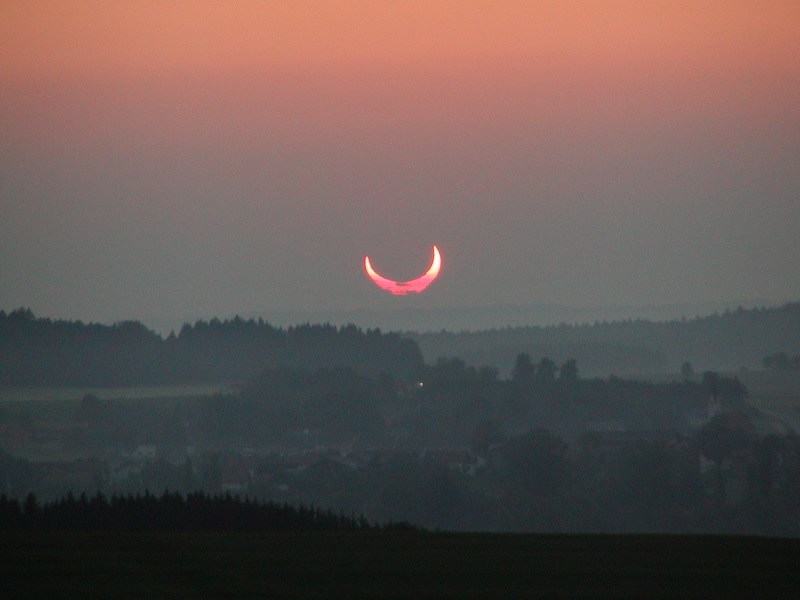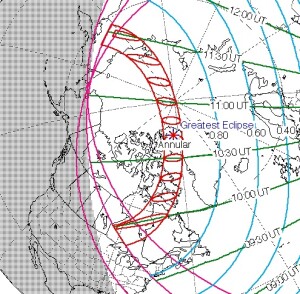
Wikimedia Commons image by Sch, licensed under the Creative Commons Attribution-Share Alike 3.0 Unported license.
The photo above was taken in Bavaria at sunrise during the eclipse of May 31, 2003. That was an annular eclipse, meaning that the sun is never entirely obscured by the sun. Because the moon is slightly too far away, there remains a ring of sunlight. It’s essentially the same as a partial eclipse, in that the world does not get appreciably darker. It’s an interesting phenomenon, but not particularly amazing. In most places, if nobody told you it was in progress, you might not even notice. For example, I drove to Springfield, IL, to see the annular eclipse of May 10, 1994. It was somewhat interesting, but there really wasn’t much to see.
There are two exceptions however, one of which is shown in the photo. At sunrise and sunset, the disc of the sun is visible. So if the annular eclipse (or a partial eclipse) is happening at sunrise or sunset, it will be quite apparent.

Path of June 10, 2021, eclipse. NASA image.
There will be an annular eclipse in North America on June 10, 2021. It’s drawn little attention, since most of the path of annularity will be over unpopulated areas in Northern Canada, Greenland, and Siberia. Much of the Canadian path is over Hudson Bay and James Bay. So unless you’re one of the few thousand Canadians living in the path, the event will be of little interest.
However, the one exception where the eclipse is visible over inhabited areas is also the one place where the phenomenon will be most interesting: The partial or annular eclipse will be visible at sunrise in Northwestern Ontario, near the city of Thunder Bay. In Thunder Bay, the sun will be about 70% covered by the moon at sunrise, and the sunrise should clearly show the partially eclipsed sun. Just a few miles northeast of Thunder Bay, there will be an annular eclipse at or near sunrise, which should result in a view similar to the one shown above.
I have two viewing locations in mind. I’ve already made a hotel reservation in Longlac, Greenstone, Ontario, which is 305 km from Thunder Bay along the Trans-Canada highway. The lawn in front of the hotel seems to have a good view of the sunrise. From my home in Minnesota, it’s about a 9 hour drive. That’s actually my backup plan, since I was already able to make a refundable hotel reservation. My primary viewing location is Macleod Provincial Park, where the campground is next to a lake, which seems to have a good view of the sunrise. Camping reservations, however, are only available five months in advance. So in January, I plan to make reservations, and after they are secured, I’ll cancel the hotel in Longlac (and I’m sure it will get snatched up quickly, since it’s one of the few hotels in the path of annulaity.)
It should be a spectacular view, but there are two possible problems. The first is the possibility of cloud cover, since there appears to be cloud cover about 60% of the time in this part of Ontario. As we did in 2017, we’ll just have to hope for the best, and perhaps plan to drive a few miles to a break in the clouds.
The other potential problem, of course, is COVID-19. Since March, the U.S.-Canadian border has been closed to non-essential travel, and this trip is clearly non-essential. Again, I’ll have to hope for the best. If the border remains closed, there will be about 16% coverage of the sun at sunrise at home in the Twin Cities. So it won’t be particularly spectacular, but it will be worth getting up to view.
But as one heads northeast, the coverage gets greater. For example, in Duluth, MN, there will be about 40% coverage of the sun as the sun rises over Lake Superior. Just south of the border at Grand Portage, the coverage will be about 70%. Anywhere along the North Shore of Lake Superior between these two points, the view should be spectacular as the sun rises over the lake. So if the border is still closed, that’s probably where I will be.
Other cities in North America will experience a spectacular sunrise that morning. In Toronto, for example, the coverage will be about 72%. Philadelphia, New York, and Boston will all have coverage of more than 70%. Winnipeg will have about 40% coverage at sunrise, and much of Saskatchewan will have at least some coverage at sunrise. Further west, Fairbanks, Alaska, is the only other North American city with anything to see, with about 24% coverage at sunrise.
